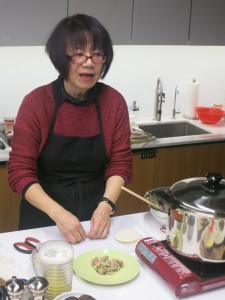
I was honored to observe, my friend and fellow writer teach a cooking class to celebrate Chinese New Year and the Year of the Monkey.
Stephanie is a master when it comes to cooking Chinese dishes as well as making these wontons, the dish she made was the Double Happiness Shanghai Wonton & Chinese New Year Cake, and here is the recipe if you would like to make it at home to celebrate the new year with friends and family.
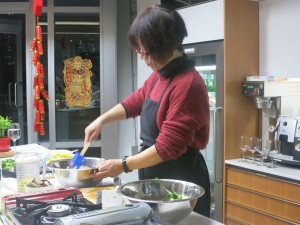
Double Happiness Shanghai Wonton & Chinese New Year Cake
Makes 40 – 50 wontons
INGREDIENTS
- 8 cups water
- 2 lbs. Shanghai bok choy, separated and rinsed
- 1 can T&T® water chestnuts, drained and diced
- 4 oz. ground lean pork (or chicken)
- ½ cup T&T® edamame beans, cooked and shelled
- 1 tbsp. light soy sauce
- 1 tsp. sesame oil
- 2 tsp. sea salt
- ¼ tsp. granulated sugar
- 2 tbsp. corn starch
- 1 small egg, beaten
- 1 pkg wonton wrap
- 2 cups Chinese New Year Cake (already sliced)
- 4 pc. T&T® dried shitake mushroom, rinsed and soaked in 2cups hot water for at least 30 minutes or until softened.
- 2 cans T&T® chicken broth
- 1/2 cup chopped cilantro (Optional)
- 1/2 cup chopped green onion (Optional)
DIRECTIONS
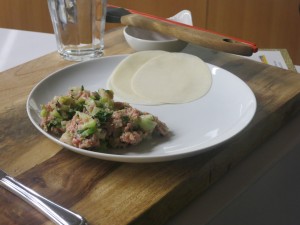
Wontons:
- Boil 6 cups of water in a medium saucepan on high heat.
- Add bok choy and blanch for 2 minutes.
- Drain the bok choy and let it cool down for 15 minutes.
- Squeeze excess water out of the bok choy and place onto a kitchen towel to let it dry.
- Chop the bok choy finely and transfer to a large mixing bowl.
- Mix water chestnut, ground pork, edamame beans, soy sauce, sesame oil, salt, sugar and corn starch into the bok choy. This is the stuffing for the wontons.
- Place one piece of wrap on a dry surface or cutting board.
- Spoon 1 tbsp. stuffing in the middle.
- Fold wrap half-way into a half circle and then using a small brush, brush a small amount of egg wash around the edge of the half circle and press firmly.
- Turn the half circle to overlap ½ inch of the two corners, brush with egg wash and press firmly. Continue until the stuffing is gone.
- Remove mushrooms from water, cut off the stems and julienne.
- Reserve mushroom water for later.
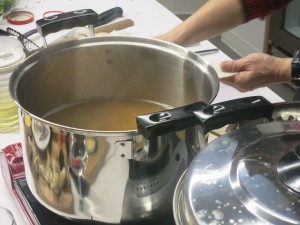
Broth:
- Combine 2 cups of water, chicken broth, mushroom and mushroom water in a medium saucepan and bring to a boil. Once it boils, cover and turn the heat down to low and let simmer.
To finish:
- Boil ½ pot of water and cook half of the wontons in the boiling water for 4-5 minutes.
- Transfer the cooked wonton into a big bowl using a slotted ladle.
- Repeat with the remaining wontons as needed*.
- Bring the chicken broth to a boil and add New Year Cake and cook for 1 to 2 minutes.
- Add cooked wonton and bring to another boil. Turn off heat.
- Top with chopped cilantro and green onion.
*Tip: Freeze unused wontons in a sealed plastic bag. Wontons can be stored for up to 2 weeks.
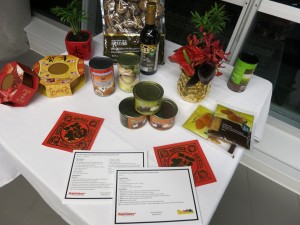
Five things you probably didn’t know about Chinese New Year
This year, embrace your inner monkey and swing head first into the Chinese New Year. Take the lead from the animal of the year – a fun little guy that’s notoriously mischievous, clever and curious – and seize the opportunity to explore an unfamiliar cultural tradition or a new take on an old holiday favourite. To help you on your journey to discovery, the team at Real Canadian Superstore® and No Frills® has put together the top five things you may or may not know about Chinese New Year.
Snacks are Symbolic
Many people are aware that food and drink play an important role in the celebration, but did you know that certain ingredients have special significance? Kumquat fruits are popular, for example, because their name in Cantonese and Mandarin sounds similar to the words for gold and good luck. Mandarins, too, are thought to bring about luck and good fortune. Leeks are also a favourite dish – cut to resemble coins, they are believed to encourage a year of wealth.
Meals are Served in Style
Food preparation is important too. Chicken and fish are often served whole, with the head and tail, to symbolize a good year from beginning to end. Noodles are made and served as long as possible to represent a long and healthy life and treat trays are served with eight compartments, a traditionally lucky number.
Families Sweep the Dust
Rituals designed to encourage health and good fortune extend beyond the dinner table. In the lead up to the New Year, homes are cleaned from top to bottom, old things are put away and windows and doors are opened to bid farewell to the old and welcome the new. But when New Year’s Day arrives, cleaning supplies are put aside so good fortune is not accidentally swept away.
The Year Starts with a Bang
Fireworks are also used to drive away evil from the coming year. Vibrant and colourful, fireworks are central to the Chinese New Year festivities, lighting up the night sky and filling the evening with joy and wonder. Did you know that some Canadian cities have even made exceptions to their by-laws to facilitate the fireworks fun?
Families Gather
The Chinese New Year’s Eve and New Year’s Day are all about family. On the eve, loved ones gather for Reunion Dinner, where they sit at round tables to enjoy food and quality time together. In the morning, many welcome the New Year with a respectful gesture, as the younger generation serves tea to their parents and grandparents. During Chinese New Year’s Day, grownups will give red envelopes with money inside to children as a sign of good fortune and wealth.
Here are some tips, recipes and more to help you experience Chinese New Year in a whole new way.
By: Richard Wolak
